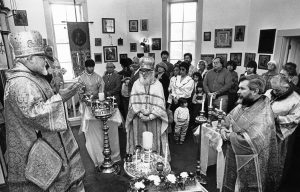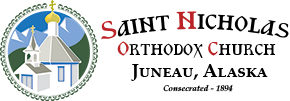Orthodox Practice and Tlingit Identity

By Fr. Simeon B. Johnson
Most of our Tlingit people adopted Orthodox Christianity in the late 1880s and early 1890s. They did not adopt Orthodoxy from the Russians under threat of Russian Colonial pressure, but they adopted Orthodox Christianity after many elders received visions of St. Nicholas telling them to take their faith from “the Russians.” It was never Orthodoxy’s intent that all Native Americans become “Russian” to be Orthodox. Instead, the Russians, following long-standing Orthodox custom, began translating the service books into the Tlingit language and, as is well documented, took on a role as defender of Native rights against American abuses.
When one becomes Orthodox, one does not have to abandon one’s Tlingit identity to do so. If you are Tlingit of the Raven moiety when you are baptized, you are Tlingit and Raven after you are baptized. Orthodoxy does not invalidate any of our Native identity, but it adds an at.óow to our lineage. When we are baptized as Orthodox, your identity becomes Orthodox, Tlingit, Raven/Eagle, and so on, but Orthodoxy becomes the primary at.óow. With Orthodoxy as the primary at.óow, one is never expected to “leave the Indian outside the church.” If you have to leave your Tlingit identity outside when you come to Orthodoxy, this means that you can’t be Tlingit and also be saved. This is not only spiritual schizophrenia, it is heresy!
“If you have to leave your Tlingit identity outside when you come to Orthodoxy, this means that you can’t be Tlingit and also be saved. This is not only spiritual schizophrenia, it is heresy!”
The task, then, is to pick up the old work of the mission and continue translation of our services, and more importantly, our cultural understanding of Orthodoxy, into Tlingit. The original translation work stopped after 1917, when the Bolsheviks overthrew the Tsar and launched a bloody campaign against the Church. The work of translating services and Scripture into Tlingit became less urgent as the American educational system and the boarding schools gradually squelched the language and fewer and fewer people understood Tlingit.
Equally as important to Orthodoxy’s translation efforts is a cultural translation. Orthodoxy has a unified dogmatic approach. Greek Orthodoxy, Russian Orthodoxy, etc. do not teach different dogmas. Orthodoxy is Orthodoxy, but anyone who has visited a Greek Orthodox parish, a Serbian Orthodox Parish, or an OCA parish knows that they each have a unique cultural feel. Frankly, from my experience, there are different parish cultures in different regions of the OCA. New York parishes did not look like Rocky Mountain deanery’s parishes. Alaskan parishes will also have different cultural feels, because each of the Alaskan peoples bring their unique culture to the way they operate. A Tlingit parish will no more look like a Yupik parish than it will look like any suburban OCA parish Outside of Alaska. Neither will the parishes in Hoonah and Angoon look exactly like the Cathedral in Sitka or the very pan-Alaskan and pan-Orthodox church that Juneau, being in the capitol of Alaska, must be. Frankly, attempts to force a particular vision of parish governance based on models imported from “outside” and without sufficient respect to local custom have caused a great deal of heartache and spiritual damage in Southeast Alaska.
How, then, do we come to a great enough of an understanding of how Orthodox customs and canon law interact with the ancient customs of the Tlingit people? It will be a challenging discussion and will, as I mentioned in a discussion of canon law with the parishioners of Hoonah, require akriveia, which is the ancient Greek word for precision, to gather all the facts we can. I have much to learn about Tlingit ways, and I cannot tell anyone HOW to be Tlingit in the 21st Century. I can, however, teach about the Orthodox Faith. If we work together, the Tlingit can teach me about their ways and I can teach Orthodoxy with all the precision needed to find genuine balance between Tlingit ways and Orthodox ways and restore our parishes to health.
